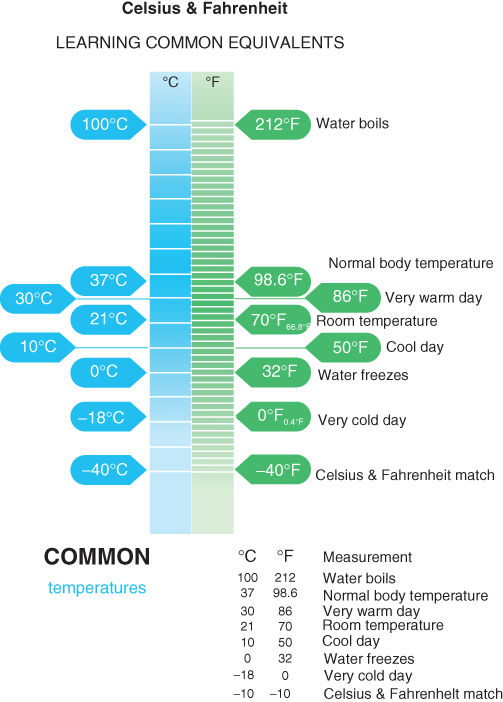16
Measurements
16.1 The Metric System
Defined by Wikipedia, the Metric System is a, “international decimalized system of measurement that was originally based on the mètre des archives and the kilogramme des archives introduced by France in 1799.”
Over the years, the definitions of the meter and kilogram have been refined and the metric system extended to incorporate many more units. Although a number of variants of the metric system emerged in the late nineteenth and early twentieth centuries the term is now often used as a synonym for “SI” or the “International System of Units” (French: “Système international d'unités”) – the official system of measurement in almost every country in the world.
| Measurement | Metric units | English units |
| Length (Länge) | mm, cm, m, km | inches, feet, yards, miles |
| Speed (Geschwindigkeit) | km h−1 | mi h−1 |
| Temperature (Temperatur) | °C | °F |
| Volume (Volumen) | ml, l | pints, quarts, gallons |
| Weight (Gewicht) | mg, g, kg | ounces, pounds (lbs.), tons (not to confuse with,  ) ) |
Of the world's major industrialized nations, the USA is the only country that has not fully endorsed the metric system as its official system of measurement, even though the metric system has been officially sanctioned for use there since 1866.
Although the UK committed to officially adopting the metric system for many measurement applications, it is still not in universal use in the UK. Below, we will tackle differences between the Metric and certain English units of measurements.
16.1.1 Measuring Temperature – Comparing Celsius (°C) Versus Fahrenheit (°F) Temperatures
When we think about temperature, and measuring with a thermometer, what units do you measure in? Did I hear you say Celsius (°C)? Correct! However, temperature in English units are measured in Fahrenheit. The physicist Daniel Fahrenheit developed a scale, which dealt with the following temperatures:

Figure 16.1 http://fivejs.com/free-celsius-and-fahrenheit-conversion-chart/.
QUIZ YOURSELF
- Freezing point of H2O = 32 °F…so what is this temperature in °C?
- Human body temperature = 98.7 °F (currently, the accepted °F reading)…so what is this temperature in °C?
- Boiling point of water = 212 °F…so what is this temperature in °C?
16.1.2 Measuring Sizes with the Metric System
| Object | Size | Viewing Instrument |
| Small molecule | 1 nm | Electron microscope |
| Virus | 100 nm | Electron microscope |
| Bacterium | 1 µm | Electron microscope/light microscope |
| Animal cell | 10 µm | Electron microscope/light microscope |
| Plant cell | 100 µm | Electron microscope/light microscope |
- 1 m (meter) = 100 cm
- 1 cm (centimeter) = 0.01 or 1 × 10−2 m
- 1 mm (millimeter) = 0.001 or 1 × 10−3 m
- 1 µm (micrometer) = 0.000001 or 1 × 10−6 m
- 1 nm (nanometer) = 0.000000001 or 1 × 10−9 m
- 1 Å (Angstrom) = 0.0000000001 or 1 × 10−10 m.
16.1.3 QUIZ YOURSELF: Measuring Sizes with the Metric System
- If a laboratory researcher uses an electron microscope, which of the following statements is false?
- a. Viruses will be observable
- b. An object or specimen can be viewed between 0.00001 m and 0.00000001 m
- c. Nanometer measurements will not be possible
- d. Rod, spiral, and round shaped Prokaryotes (Bacteria) can be seen
- Which statement is correct?
- a. Animal cells are larger than plant cells
- b. Bacteria are smaller than viruses
- c. Plant cells are equal in size to animal cells
- d. None of these
- Which statement is correct?
- a. With only a light microscope, viruses such as polio can be observed between 100 and 10 nm
- b. With a light microscope, bacteria such as Staphylococcus can be observed near 1 × 10−6 m
- c. With only an electron microscope, plant cells from either an onion or cork can be observed between 1 cm and 1 m
- d. With an electron microscope, animal cells such as human red blood cells (RBCs) can be observed near 1 × 10−7 m.
16.2 The Micro Versus Macro Worlds
What comparisons can you make between the uni-cellular, Amoeba and the multi-cellular, Hippopotamus?

Figure 16.2 (a) Hippopotamus and (b) Amoeba. (© kameleonmedia – fotolia.com and © designua – fotolia.com.)
16.2.1 The Microscope, an Instrument Used to Observe the “Micro-World”
When viewing the micro or ‘small’ world, what instrument is most likely used? Did I hear you say, Microscope as in a an illuminating, light reflecting mirror or electron microscope? However, when viewing the macro or ‘large’ world, what instruments are typically used? Lets now take a look at the macro world, and use of telescopes.
16.2.2 The Telescope, an Instrument Used to Observe Our “Macro-World.”
Like with the microscope, various types of telescopes exist.
- Radio Telescopes: Very Large Array, New Mexico, USA, which picks up distant radio waves
- Refracting Telescope: Mt. Wilson Observatory, LA, California, USA, which uses lenses at both ends
- Reflecting Telescope: Hale Reflecting Telescope, Mt. Palomar, California, USA uses a 5.1 m reflecting mirror
- X-ray Telescope: Einstein X-ray Telescope orbiting Earth
- Hubble Space Telescope: Launched by the Space Shuttle in 1990, it orbits Earth and uses two special mirror to form focused images over the largest possible field of view.